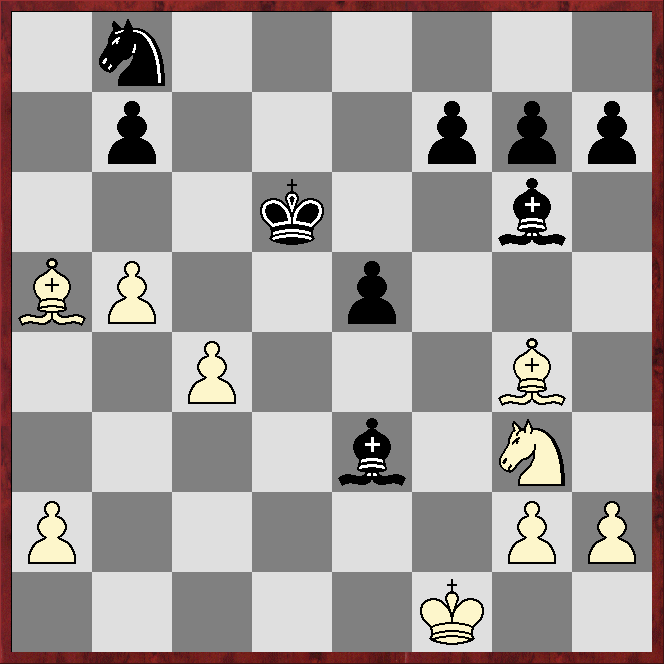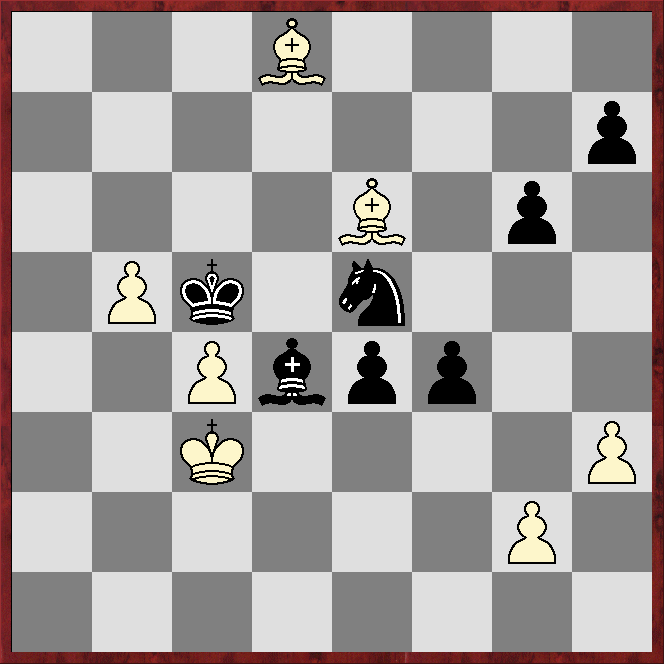Spanton (1858) - Alois Bartoš (1884)
Veresov
1.d4 Nf6 2.Nc3 d5 4.Bg5 c5 5.e4!?
This aggressive continuation is nowhere near as popular as 5.e3 and especially 5.Bxf6, but dates back to at least a 1934 game of Kurt Richter, after whom the opening is sometimes named.
4...Nxe4 5.Nxe4 dxe4 6.dxc5!?
Strong players have tended to prefer 6.d5, in Albin Countergambit-style, but Stockfish16 and Komodo14.1 like the text.
6...Qa5+ 7.Qd2 Qxd2+!?
The engines slightly prefer this to grabbing a pawn with 7...Qxc5, when they reckon White has sufficient compensation.
8.Bxd2 e5 9.b4 10.c3 Bf5
The engines prefer 10...Nc6 or 10...Be6, apparently wanting to leave the f5 square for the black f pawn.
11.Ne2
And they dislike this because Black can reply 11...Be6, meeting 12.Ng3 with 12...f5, so instead they suggest 11.Bc4.
11...Be7 12.Ng3 Bg6 13.Bb5+ Nc6 14.0-0 0-0
*****
*****
*****
*****
Material is level, both sides have doubled pawns and both sides have a pawn-majority with two extra pawns (4-2 on the queenside for White; 5-3 on the kingside for Black). The engines reckon the position is equal.
15.Rfd1 Rfd8 16.Bc4?!
Probably better is 16.a4.
16...Rd7
The engines point out Black can get rid of his doubled pawns with 16...e3!, one point being 17.fxe3? runs into 17...Bc2 or, possibly even better, 17...axb4 18.cxb4 Bc2. White can play 17.Bxe3, but 17...axb4 18.cxb4 Nxb4 favours Black, or 17.Be1, but then 17...exf2+ 18.Kxf2 axb4 19.cxb4 Nd4 gives Black at least a slight edge, according to the engines.
17.Be1 Rad8 18.Rxd7 Rxd7 19.Bb5 Kf8 20.Ba4 Rd8 21.Rd1 Raxd1 22.Bxd1 Ke8
*****
*****
*****
*****
23.b5?!
A little combination to undouble White's c pawns, but it frees Black's game, and at the end of the combination Black gets rid of his doubled pawns. Almost certainly better is 23.Bg4.
23...Nb8 24.c4 Bxc5 25.Bxa5 e3 26.fxe3 Bxe3 27.Kf1 Kd7?!
Black should probably bring the knight back into play with 27...Nd7.
28.Bg4+ Kd6
The engines prefer retreating with 28...Ke7!?
*****
*****
*****
*****
29.Nf5+
This wins the bishop-pair, but the engines much prefer 29.Bf5!?, when 29...Bxf5?? loses a piece to 30.Nxf5+, and 29...Kc5?? loses a piece to 30.Bc7. Best, according to Stockfish16, is 29...b6 30.Bb4+ Bc5. Komodo14.1 also likes that line, and 30.Ne4+. In both cases White has an initiative, while after ...
29...Bxf5 30.Bxf5 g6 31.Bd3 Nd7
... Black's strong king seems to compensate for the bishop-pair.
32.Ke2 Bg1 33.h3 Kc5 34.a3 f5 35.Kd2 e5 36.Be2 b6 37.Bb4+ Kd4 38.a4 f4 39.a5 bxa5 40.Bxa5 Kc5 41.Kc3 Bf2 42.Bb4+ Kb6 43.Be7 Be3 44.Bg5 Kc5 45.Bg4 Ne5 46.Be7+ Kb6 47.Bd8+ Kc5 48.Be6 Bd4+
*****
*****
*****
*****
49.Kd2?
Drawing is 49.Kb3, and possibly 49.Kc2!?, as I will explain later.
49...Nxc4+ 50.Bxc4 Kxc4 51.b6 Kb5
If the white king were on c2 instead of d2, White could play 52.Bc7, winning the f pawn with good drawing chances (Stockfish16 reckons the position is equal, although Komodo14.1's evaluation of the upper hand for Black may be nearer the mark, at least in practical play).
52.b7
If 52.Bc7? then 52...Be3+ followed by 53...Kc6 wins.
52...Be5 53.Bf6 Bb8 54.Kc3 Kc6
The engines' 54...Kc5!? is probably even stronger, eg 55.Bg5 Be5+ 56.Kd2 Kc6 etc.
55.Kd4 e3 56.Kd3 Kxb7 57.g3 fxg3 58.Kxe3 Kc6 59.Kf3 Kd5 60.Bh4 Ke6 61.Bxg3?
The pawn-ending is trivially lost. Komodo14.1 reckons Black is also winning if the bishops stay on, but Stockfish16 reckons in that case Black only has a slight edge. What suggests it may indeed be drawn is that the engines' evaluations are exactly the same after most White moves, eg 61.Kg2, 61.Bd8 and 61.Bg5 (+2.2 for Black, according to Komodo14.1; +0.75, according to Stockfish16), which is often the sign of a position where a material advantage cannot be converted into a win with best play.
61...Bxg3 62.Kxg3 Kf5
Also winning is 62...Ke5, but pushing either pawn would only draw (Syzygy endgame tablebase).
63.h4 h6 64.Kf3 h5 65.Kg3 Ke4 0-1




No comments:
Post a Comment